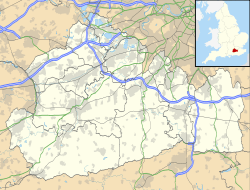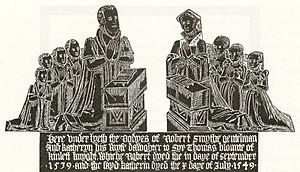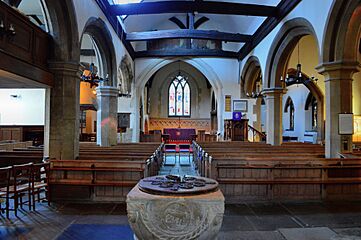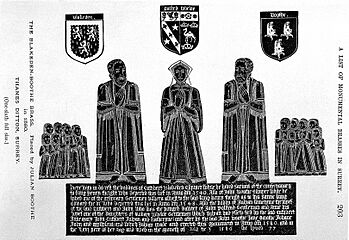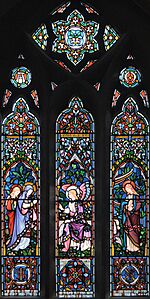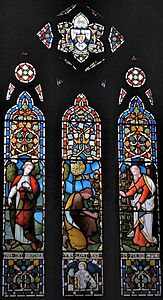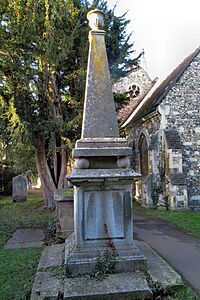Church of St Nicholas, Thames Ditton facts for kids
Quick facts for kids Church of St Nicholas, Thames Ditton |
|
|---|---|

St Nicholas's Church
|
|
| 51°23′33″N 0°19′58″W / 51.392618°N 0.332682°W | |
| Location | Thames Ditton, Surrey |
| Country | England |
| Denomination | Church of England |
| Website | St Nicholas's Church website |
| History | |
| Status | Consecrated |
| Architecture | |
| Functional status | Active |
| Heritage designation | Grade I listed |
| Architectural type | Medieval, Gothic and Neo-Gothic |
| Specifications | |
| Materials | Body: sandstone-dressed flint and brick Roof: plain tiles and slate |
| Administration | |
| Parish | Thames Ditton |
| Archdeaconry | Dorking |
| Diocese | Guildford |
St Nicholas Church is a very old church in Thames Ditton, Surrey, England. It's a special building, listed as Grade I, which means it's super important. Some parts of this Church of England church are from the 1100s!
Contents
History of the Church
How the Church Started
After the Norman Conquest (when the Normans took over England), a Norman lord gave land and money from his estate to the monks of Merton Priory. This happened during the time of King Henry I (1100–1135).
A man named Gilbert the Norman, who was a High Sheriff of Surrey, gave the right to choose the priest for the church in Kingston upon Thames to Merton Priory. He also gave them four smaller churches, or "chapelries," including the one in Thames Ditton.
Gilbert died in 1125, so we know there was a working church in Thames Ditton around 1120. The oldest stone parts of St Nicholas Church are from the 12th century. We even know that a priest named 'William' was the Vicar of Thames Ditton starting in 1179.
Changes Over Time
Later, in 1538, after King Henry VIII closed down many monasteries, the right to choose the priest for St Nicholas Church went to private owners. For a long time, the owners of a nearby estate called Imber Court helped pay for the church's priest.
By 1848, the church was looked after by King's College, Cambridge. This shows how the church's ownership and support changed a lot over hundreds of years.
Church Building and Special Features
What the Church is Made Of
The church building is mostly made from flint stones with stone details. The tower is a mix of brick and stone, with some tile patches. The roof is made of flat tiles, but the porch roof is slate.
Because of all the different materials, you can tell the church has been changed many times. Not much of the very first building is still visible today.
Oldest Parts and New Additions
The oldest parts of the church are probably the north wall of the chancel (the area around the altar) and the walls of the tower. These parts are from the original Norman building and have narrow, tall windows called lancet windows.
Over the years, more sections were added. A chapel was built on the north side in the 1300s, and a north aisle (a side section) was added in the 1400s. The vestry, a room for the clergy, was first built in 1676 as a burial place. The north aisle was made bigger in 1836, and a south aisle was added in 1864.
Amazing Things Inside
- The Font: St Nicholas Church has one of the most beautiful fonts in Surrey. It's from around 1120 and has unique carvings. On its four sides, you can see a lamb (called an Agnus Dei), a goat, a star, and a special cross. A stone basin, called a piscina, also from the 1100s, was found when they were building the new south aisle in 1864.
- Doom Pictures: Above the arch leading to the chancel, there are painted boards called 'Doom Pictures'. They show the Day of Judgement and are from around 1570. These paintings are very rare because most like them were destroyed during the Reformation. They are made of 11 oak panels, painted simply in red, green, black, and white. Part of a central crucifix is missing. They were found in 1893 and later restored. Long ago, the church would have been very colorful, with painted columns and walls showing religious stories.
- Forde Monument and Brass: The church has a special monument and a brass plaque for Erasmus Forde. The stone monument might have been designed for two kneeling statues. The Forde brass shows Erasmus Forde in armor, his wife Julyan, and their 12 daughters and six sons kneeling. Another brass for Erasmus and Julyan Forde is famous for having one of the earliest uses of the phrase "Que Sera, Sera" (meaning "Whatever Will Be, Will Be").
- Hatton Chapel: In 1676, a man named William Hatton built a family burial chapel next to the church. It was called DORMITORIUM HATTONIANUM. Some of his family members were buried there. However, it fell apart and was rebuilt as a vestry in 1781. The Hatton family also left money to help support the vicars of Thames Ditton.
- Church Bells: Bells were first mentioned in the church in 1552. Their number was increased to six in 1753. The bells were remade in 1962 and put into a new frame in 1981.
- Stained Glass Windows: The large east window is from the 1900s and shows St Nicholas. It is set in a frame from the 1300s. Other windows were made by artists named Lavers, Barraud and Westlake. These include "The Three Maries at the Sepulchre," and windows showing St John the Baptist, St Mary Magdalene, St Augustine, and St Nicholas.
Gallery
See also


